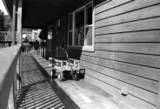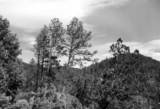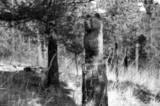home vintage cameras index

The lens design of the Model B predates the Rapid Rectilinear by at least several centuries, going back to a time before Galileo. Of course, by the time of Kodak's introduction of the Model B, many advances had been made in the manufacturing process for grinding spherical lenses. It had been discovered that differing glass formulae could enhance light transmission and reduce aberrations, and multiple lens elements could combat distortion inherent in the spherical design. Anti-reflective coating was still in the future when the Model B appeared, but having the lens well-recessed behind the shutter was helpful in maintaining image contrast.

When viewed from the front, the Model B appears to be missing a lens; there is just a gaping round hole with no glass visible. Inside the hole, one can discern the blades of the aperture diaphragm and the shutter. As it turns out, the single meniscus lens is located behind the shutter. (A meniscus lens has a convex and a concave side, and the curvature of both are equal.)

I don't know how much of the knowledge about lens design current at the time was incorporated into the Model B, but it is capable of making very nice images. As with any simple meniscus design, there is some softness around the image margins and a bit of barrel distortion. However, a steady hold on the camera will yield centrally sharp images supporting considerable enlargement.
The Model B has all the basic features needed for photography under nearly any set of conditions. The variable speed shutter has T,B,25 and 50 settings, along with provision for a cable release. The aperture adjustment has four settings, marked 1, 2, 3, 4. Kodak, like other manufacturers, experimented for a time with several systems to designate aperture settings including this one before settling on the currently used f-stop system. The Model B settings are equivalent to the current day values of f11, f16, f22 and f32. The camera is focused by drawing out the lens so that a latch engages notches on the focusing scale marked for 100 feet, "Fixed", and 8 feet. The weakest link in the Model B system is probably the reflex viewfinder which is quite tiny and rather dim.
Here are some sample photos from the Model B made on Kodak TMAX 100 film and developed in Ilford DDX.




home vintage cameras index
 © mike connealy
© mike connealy